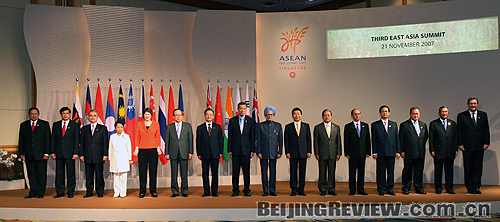|
|

A BIG FAMILY: Leaders pose at the Third East Asia Summit in Singapore on November 21, 2007. The Association of Southeast Asian Nations leads the pack in East Asian cooperation | The Association of Southeast Asian Nations (ASEAN) Charter came into force at the Special ASEAN Foreign Ministers' Meeting in Jakarta, Indonesia, on December 15, 2008, a milestone achievement that brought the ASEAN integration process within a legal framework.
"The charter can be the basis for speeding up and strengthening our regional integration," said Indonesian President Susilo Bambang Yudhoyono in a statement. "By virtue of its provisions, we can enhance the process by which we are transforming ASEAN from a loose association to an ASEAN Community resting on the pillars of politico-security cooperation, economic cooperation and socio-cultural cooperation. It also provides for ASEAN's elevation to a rules-based and people-centered organization with a legal personality." Indonesian media hailed the charter's entry into force as a major step toward turning ASEAN into a European Union (EU)-style economic bloc.
Far-reaching implications
Principles set out in the ASEAN Charter include: maintaining and enhancing peace and security in the region; creating a single market and production base; strengthening democracy, good governance, the rule of law and human rights; responding effectively to all forms of threats, transnational crimes and transboundary challengers; alleviating poverty and narrowing the development gap within ASEAN; promoting sustainable development and protecting the environment, natural resources and cultural heritage; developing human resources and enhancing the well-being of the people in ASEAN; and promoting an ASEAN identity.
The ASEAN Charter's entry into force has four major implications:
--It defines the direction of development for Southeast Asia. Southeast Asian nations must join forces to strengthen themselves to become masters of the region. They empower themselves by speeding up modernization while preserving their traditional features. At the same time, they give scope to their collective strength through ASEAN. This two-pronged approach is a correct choice made by Southeast Asian countries after World War II. Since the 1990s, ASEAN has stepped up its integration process. It first worked for the establishment of a free trade area among ASEAN countries at an early date and then set the goal of establishing an ASEAN Community by 2015. The ASEAN Charter serves as a general guide for ASEAN integration.
--The ASEAN Charter is designed to address new internal and external challenges. Over the past 41 years since its inception, ASEAN has adjusted itself in keeping up with changes in the region and beyond. Today, it has to coordinate relations among its members to deal with a host of new problems such as economic globalization, structural changes in the power dynamics in Asia, non-traditional security threats and ASEAN's internal problems. The organization needs to codify new principles and approaches suited to the new circumstances. The purpose of adopting the ASEAN Charter is to transform ASEAN from a loose organization to one based on a legal framework.
--It helps enhance ASEAN's role in leading East Asian cooperation. Since the end of the Cold War, ASEAN has not only succeeded in striking a balance in its relations with major powers, but has also come to lead regional cooperation in East Asia. Given the complex international relations in East Asia, all regional powers accept ASEAN's leading role in East Asian cooperation. ASEAN charts the course for East Asian cooperation, while coordinating relations among different countries. No single ASEAN country is able to play this role. In this sense, ASEAN integration has a direct bearing on the sustainable development of its influence.
|
